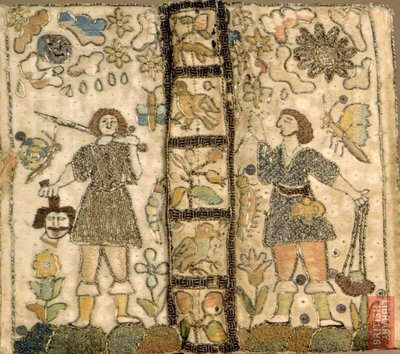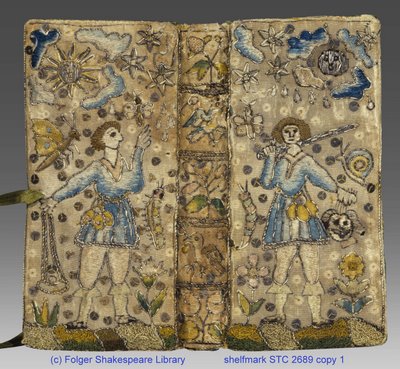I know what you’re thinking. Gee, this looks familiar:
And it ought to. Compare it to this:
The first is a Book of Psalms from the British Library’s collection, with an embroidered binding depicting David and his slingshot on the front panel and David with Goliath’s head on the back. The second is our friend from my last posting, a Book of Psalms from the Folger, with an embroidered binding depicting David with Goliath’s head and, yes, David and his slingshot.
I’ll wait while you compare the two (clicking on each image should bring you to an enlargeable picture).
That’s right–they’re the same! Of course, they’re not exactly the same. The BL binding reveals that what I took as a cheesy grin from Goliath is actually a mustache, the Folger David holding Goliath’s head has a unibrow that the BL David does not, and the Folger binding has a much more soothing color scheme of blues. And I like that the BL copy reverses what was, to my sense, a weirdly backwards chronology of encountering the beheaded Goliath before you meet David with his slingshot. Those tiny differences aside, these are two bindings obviously done from the same pattern for two different psalters.
I stumbled across the BL book when I was scouting out a response to a comment on my last post. Lycimnius wondered about the date of the binding because he was struck by the approaching date of Charles I’s beheading. The Folger’s catalogue identifies the binding as approximately 1639, a date obviously taken from the publication of the text. The BL book is a 1640 copy, which makes me suspect that the embroidery was done closer to the publication date than 10 years on.
In any case, I was browsing through the British Library’s database of bookbindings looking to see what examples of embroidered books they had, when lo and behold, there was my David! There are lots of other examples in their database (do a quick search for “embroidered” to see for yourself). For those of you wanting to learn more about embroidered bindings, there’s a brief research guide provided by the BL’s Philippa Marks, Curator of Bookbindings, Early Printed Collections. The key points to know are that such bindings were typically done by professionals, often from pattern books or other sources. Religious works, such as the Books of Psalms that I’ve been using as examples, are the most frequent texts bound this way. Embroidered bindings reached their height of popularity during the seventeenth century, and largely disappeared after the Civil War.
I don’t have any answer for Lycimnius about the relative popularity or lack thereof for depicting the slaying of Goliath on psalters–images of David are popular, of course, given his status as author of the Psalms, but they tend to depict him with his harp (see this or this as examples). But I was pretty thrilled to find another example of the same pattern, thus answering a question I hadn’t even realized I was asking.

